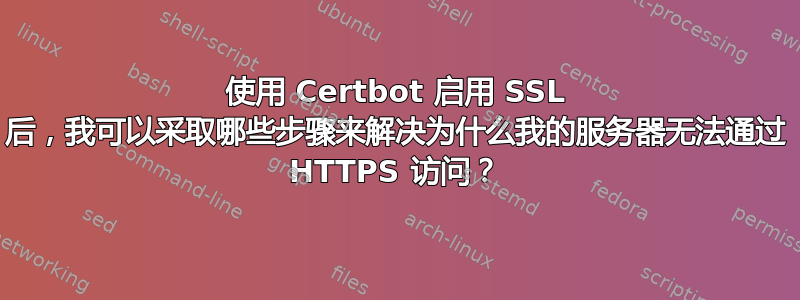
我正在寻求帮助来诊断和解决此问题。在使用 Certbot 启用 SSL 后,我可以采取哪些步骤来排除服务器无法通过 HTTPS 访问的故障?我可能错过了哪些常见的陷阱或配置设置?
如能得到有关解决此 SSL 问题的任何帮助或指导,我们将不胜感激。
我已经使用了这个命令 certbot 命令 sudo certbot --nginx 并且语法成功了 在 certbot 命令之后我无法访问我的服务器它在 http 中工作但在 https 中不工作
这是 sites-available 下的文件。文件名为 default
##
# You should look at the following URL's in order to grasp a solid understanding
# of Nginx configuration files in order to fully unleash the power of Nginx.
# https://www.nginx.com/resources/wiki/start/
# https://www.nginx.com/resources/wiki/start/topics/tutorials/config_pitfalls/
# https://wiki.debian.org/Nginx/DirectoryStructure
#
# In most cases, administrators will remove this file from sites-enabled/ and
# leave it as reference inside of sites-available where it will continue to be
# updated by the nginx packaging team.
#
# This file will automatically load configuration files provided by other
# applications, such as Drupal or Wordpress. These applications will be made
# available underneath a path with that package name, such as /drupal8.
#
# Please see /usr/share/doc/nginx-doc/examples/ for more detailed examples.
##
# Default server configuration
#
server {
#listen 443;
#listen [::]:443;
# SSL configuration
#
# listen 443 ssl default_server;
# listen [::]:443 ssl default_server;
#
# Note: You should disable gzip for SSL traffic.
# See: https://bugs.debian.org/773332
#
# Read up on ssl_ciphers to ensure a secure configuration.
# See: https://bugs.debian.org/765782
#
# Self signed certs generated by the ssl-cert package
# Don't use them in a production server!
#
# include snippets/snakeoil.conf;
root /var/www/html/waste-management-dev/public;
# Add index.php to the list if you are using PHP
index index.php;
server_name yourdomain.in;
location / {
# First attempt to serve request as file, then
# as directory, then fall back to displaying a 404.
#try_files $uri $uri/ =404;
try_files $uri $uri/ /index.php?q=$uri&$args;
}
# pass PHP scripts to FastCGI server
#
location ~ \.php$ {
try_files $uri =404;
fastcgi_split_path_info ^(.+\.php)(/.+)$;
include fastcgi_params;
fastcgi_pass unix:/run/php/php7.4-fpm.sock;
fastcgi_index index.php;
fastcgi_param SCRIPT_FILENAME $document_root$fastcgi_script_name;
#fastcgi_param SCRIPT_NAME $fastcgi_script_name;
#include fastcgi_params;
}
# deny access to .htaccess files, if Apache's document root
# concurs with nginx's one
#
#location ~ /\.ht {
# deny all;
#}
listen [::]:443 ssl ipv6only=on; # managed by Certbot
listen 443 ssl; # managed by Certbot
ssl_certificate /etc/letsencrypt/live/yourserver.in/fullchain.pem; # managed by Certbot
ssl_certificate_key /etc/letsencrypt/live/yourserver.in/privkey.pem; # managed by Certbot
include /etc/letsencrypt/options-ssl-nginx.conf; # managed by Certbot
ssl_dhparam /etc/letsencrypt/ssl-dhparams.pem; # managed by Certbot
}
# Virtual Host configuration for example.com
#
# You can move that to a different file under sites-available/ and symlink that
# to sites-enabled/ to enable it.
#
#server {
# listen 80;
# listen [::]:80;
#
# server_name example.com;
#
# root /var/www/example.com;
# index index.html;
#
# location / {
# try_files $uri $uri/ =404;
# }
#}
server {
if ($host = yourserver.in) {
return 301 https://$host$request_uri;
} # managed by Certbot
listen 80 default_server;
listen [::]:80 default_server;
server_name myserver;
return 404; # managed by Certbot
}
答案1
由于您基本上只发布了次要信息,因此基于此,配置可能会起作用:
# Default server configuration
# which means its a catch all for these that are not configured, if you use only one site, for this server you dont need a specific host
# /etc/nginx/sites-enabled/default
server {
listen 80 default_server;
listen [::]:80 default_server;
root /var/www/html;
index index.html index.htm index.nginx-debian.html;
server_name _;
location / {
# First attempt to serve request as file, then
# as directory, then fall back to displaying a 404.
try_files $uri $uri/ =404;
}
# pass PHP scripts to FastCGI server
#
location ~ \.php$ {
include snippets/fastcgi-php.conf;
#
# # With php-fpm (or other unix sockets):
fastcgi_pass unix:/run/php/php-fpm.sock;
# # With php-cgi (or other tcp sockets):
# fastcgi_pass 127.0.0.1:9000;
}
location ~ \.cgi$ {
gzip off;
include fastcgi.conf;
include fastcgi_params;
fastcgi_param SCRIPT_FILENAME $document_root$fastcgi_script_name;
fastcgi_pass unix:/var/run/fcgiwrap.socket;
}
# deny access to .htaccess files, if Apache's document root
# concurs with nginx's one
#
location ~ /\.ht {
deny all;
}
}
#### NEW FILE !!!!!!
#### /etc/nginx/sites-enabled/unwaste.in
##start file
server {
server_name unwaste.in;
listen 80;
return 307 https://$host$request_uri;
}
server {
# enable http2 support - if module if avaible
listen 443 ssl http2;
listen [::]:443 ssl http2;
# enable http1.1 support - if module if avaible
# listen 443 ssl;
# listen [::]:443 ssl;
root /var/www/html/waste-management-dev/public;
# Add index.php to the list if you are using PHP
index index.php;
server_name unwaste.in;
location / {
# First attempt to serve request as file, then
# as directory, then fall back to displaying a 404.
#try_files $uri $uri/ =404;
try_files $uri $uri/ /index.php?q=$uri&$args;
}
# pass PHP scripts to FastCGI server
#
location ~ \.php$ {
try_files $uri =404;
fastcgi_split_path_info ^(.+\.php)(/.+)$;
include fastcgi_params;
fastcgi_pass unix:/run/php/php7.4-fpm.sock;
fastcgi_index index.php;
fastcgi_param SCRIPT_FILENAME $document_root$fastcgi_script_name;
#fastcgi_param SCRIPT_NAME $fastcgi_script_name;
#include fastcgi_params;
}
# deny access to .htaccess files, if Apache's document root
# concurs with nginx's one
#
location ~ /\.ht {
deny all;
}
ssl_certificate /etc/letsencrypt/live/unwaste.in/fullchain.pem; # managed by Certbot
ssl_certificate_key /etc/letsencrypt/live/unwaste.in/privkey.pem; # managed by Certbot
include /etc/letsencrypt/options-ssl-nginx.conf; # managed by Certbot
ssl_dhparam /etc/letsencrypt/ssl-dhparams.pem; # managed by Certbot
}
#EOF
提醒一下,/etc/nginx/sites-enabled 可以使用多个文件,因此您应该这样做,并且不要触碰 nginx.conf。大多数基于 Debian 的系统(如 Ubuntu 和 co)都有相同的行为。
如果文件无法加载,则必须在 nginx 末尾采取以下措施:
include /etc/nginx/conf.d/*.conf;
include /etc/nginx/sites-enabled/*;
请先讨论而不是反对,谢谢 ;)


